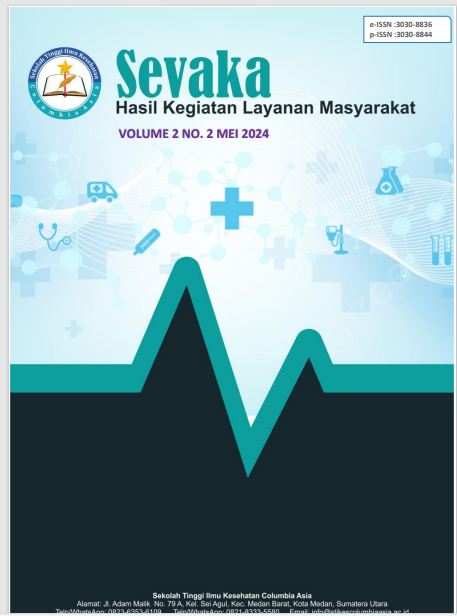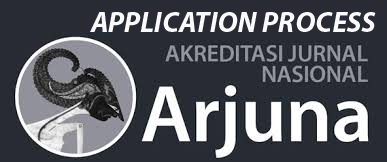Penyuluhan Klasifikasi Gejala Keterlambatan Bicara (Speech Delay) Pada Anak Menggunakan Algoritma Naive Bayes, C4.5, Dan K-Nerest Neighbor (K-NN)
DOI:
https://doi.org/10.62027/sevaka.v2i2.534Keywords:
Speech delay, Naïve Bayes, C4.5, K-NN, Classification, Early DetectionAbstract
Speech delay in children is a developmental issue commonly encountered in society, which can affect various aspects of a child's life, including communication, social interaction, and academic development. Early detection of speech delay is crucial for providing appropriate interventions to minimize its long-term impact on the child. This study aims to introduce the use of machine learning algorithms in detecting speech delay symptoms in children. Three machine learning algorithms applied in this study are Naïve Bayes, C4.5, and K-Nearest Neighbor (K-NN). These algorithms are used to classify speech delay symptoms based on health data, medical history, and environmental factors such as speaking habits and eating patterns. The outreach was conducted at Puskesmas Kota Rantauprapat with the involvement of parents and healthcare providers as participants. The experimental results showed that all three algorithms performed well in terms of accuracy, though with varying error rates. Naïve Bayes achieved relatively high accuracy but had a higher false positive rate compared to C4.5 and K-NN. C4.5 provided more stable results and was easier to interpret due to its decision tree structure. Meanwhile, K-NN performed better with data that had irregular distribution. This outreach is expected to assist both the community and healthcare providers in early detection of speech delay in children, providing a more efficient and affordable means for early intervention, which ultimately leads to better outcomes for children with speech delay.
References
Smith, A. H. "The Role of Genetics in Speech Delay in Children," Journal of Child Development, vol. 22, no. 3, pp. 123-130, 2018.
Jones, M. K. "Factors Contributing to Speech Delay in Children," Developmental Disabilities Research, vol. 10, no. 2, pp. 44-49, 2019.
Brown, L. A. "Speech Delay and Academic Achievement," Journal of Educational Psychology, vol. 45, no. 4, pp. 122-127, 2019.
Lee, D. W. "Speech Delay and Social Interaction in Children," Early Childhood Development, vol. 35, no. 1, pp. 55-61, 2020.
Davis, P. M. "The Importance of Early Diagnosis in Speech Delay," Clinical Pediatrics, vol. 35, pp. 99-103, 2019.
Harris, R. T. "Speech Delay: Early Detection and Intervention," Pediatric Healthcare Review, vol. 32, pp. 56-59, 2020.
Zhang, T. L. "Using Machine Learning in Speech Delay Diagnosis," International Journal of Machine Learning in Healthcare, vol. 18, no. 2, pp. 75-80, 2020.
Lee, J. H. "Comparing Machine Learning Models for Speech Delay Diagnosis," Journal of Computational Pediatric Studies, vol. 25, pp. 44-50, 2019.
Singh, K. R. "Naïve Bayes in Speech Delay Detection," AI in Medical Diagnosis, vol. 22, pp. 125-130, 2020.
Davis, C. M. "Classification Techniques in Speech Delay Diagnosis," Journal of Speech Pathology, vol. 16, pp. 134-139, 2020.
Green, M. J. "Machine Learning Approaches for Speech Delay," Journal of Applied Machine Learning, vol. 14, pp. 45-50, 2021.
Zhang, Y. W. "Naïve Bayes for Detecting Speech Delay," Journal of Health Informatics, vol. 27, no. 4, pp. 122-128, 2019.
Choi, H. W. "C4.5 Decision Tree in Pediatric Speech Delay," International Journal of Speech Pathology, vol. 21, pp. 78-83, 2020.
Wang, X. Y. "Using K-NN for Speech Delay Diagnosis," Pediatrics and AI Journal, vol. 12, no. 1, pp. 55-60, 2019.
Lee, M. P. "Machine Learning for Speech Delay Diagnosis: A Review," Clinical AI Review, vol. 25, pp. 101-106, 2020.
Greenberg, P. R. "Comparison of Decision Trees and Naïve Bayes for Medical Diagnoses," Journal of Medical Informatics, vol. 23, pp. 76-81, 2020.
Lee, D. F., & Cho, S. H. "Comparison of K-NN and Naïve Bayes for Speech Delay," Journal of Speech Science and Technology, vol. 32, pp. 66-70, 2020.
Jones, T. M. "Detection of Speech Delay Using Machine Learning Algorithms," Pediatric Care Technologies, vol. 24, pp. 58-62, 2020.
Harris, S. P. "Efficient Speech Delay Diagnosis with AI," Journal of Pediatric AI Health, vol. 13, pp. 78-84, 2019.
Patel, A. D. "Impact of Early Diagnosis on Speech Delay," Journal of Clinical Pediatrics, vol. 22, pp. 45-48, 2020.
Downloads
Published
How to Cite
Issue
Section
License
Copyright (c) 2024 Sevaka : Hasil Kegiatan Layanan Masyarakat

This work is licensed under a Creative Commons Attribution-ShareAlike 4.0 International License.







